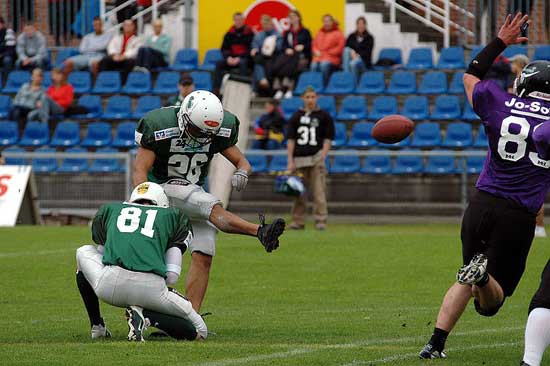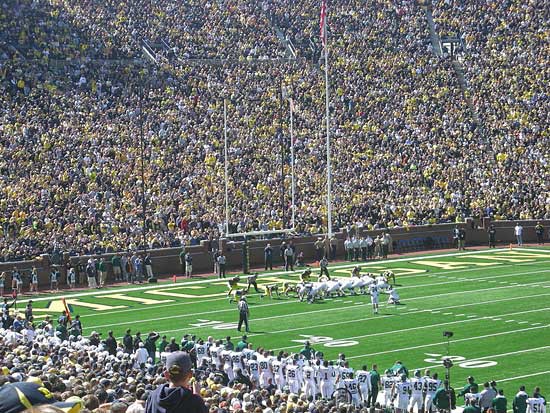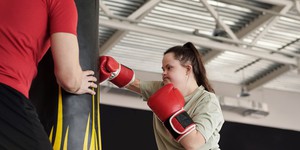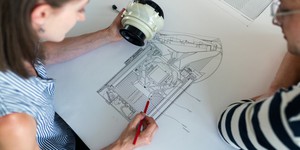Abstract
When watching a football game, have you ever wondered why some kicks lead to a successful field goal and others do not? There are a lot of variables at play in a game of football, and many of them are related to physics. One variable that can affect whether a field goal is successful is distance. In this science project, you will explore how field goal success rate is affected by distance from the goalposts. What will be the best distance for you to kick some field goals? Grab a football, head out to the playing field, and try this science project to find out!Summary

Objective
Determine how field goal success rate is affected by distance from the goalposts.Introduction
In a professional football game, there can be some amazing field goal kicks, with the longest field goals being made from 60 or more yards away! But at other times, the kicks do not quite make it through the goalposts, and are unsuccessful. Why is this? It actually has to do with physics. When an object is thrown, launched, or kicked through the air, the path it takes—also known as its trajectory—can be studied using the science of projectile motion. Applying knowledge of projectile motion lets scientists predict an object's trajectory, based on the forces acting on the object, like gravity and air resistance. This means that when a football is kicked—as shown in Figure 1—it needs to have a specific trajectory to make it through the goalposts.

Figure 1. For a field goal to be successful, it needs to have a specific trajectory that takes it through the goalposts. (Image credit: Torsten Bolten, 2005)
There are many factors that football players have to consider when trying to make a field goal, including the defense blocking the football, wind blowing the ball off course, and distance from the goalposts. When a field goal is attempted close to the goalposts—such as only 10 yards away, as shown in Figure 2, below,—the kick is almost certainly successful. But what about when it is attempted from farther away, from 30, 40, or more than 50 yards away? The force of gravity continually pulls down on the football as it flies through the air, so if the kicker is farther away, he or she must kick it harder so it will fly through the air longer. Additionally, any minor mistake in kicking the football at the beginning can be amplified over distance (and if the ball is in the air longer, any wind blowing on it will have more time to push it off course).
In this science project, you will explore how field goal success rate is affected by distance from the goalposts. At what point is the field goal success rate less than half, or even lower, and not worth attempting? Get ready to grab a football and find out!
 Image Credit: Wikimedia Commons / Creative Commons Attribution-Share Alike 3.0 Unported
Image Credit: Wikimedia Commons / Creative Commons Attribution-Share Alike 3.0 Unported
Figure 2. Close field goals, like the one attempted here at 10 yards from the goalposts, are almost certainly successful, but the success rate decreases with distance. (Image credit: Michael Barera, 2011)
Terms and Concepts
- Trajectory
- Projectile motion
- Gravity
- Air resistance
Questions
- Can you think of a football game where a long field goal was surprisingly successful? What about when a short field goal kick was unsuccessful? What factors affected whether these kicks were successful?
- What are some forces that affect an object in projectile motion, and how do these forces specifically affect the object's trajectory?
- What field goal success rates do you think NFL players usually have at 10 yards from the goalposts? What about 20, 40, or 60 yards away? Hint: Check out the resources in the Bibliography, below, to help you answer this.
Bibliography
To find out more about projectile motion, check out this webpage:- The Physics Classroom. (n.d.). Projectile Motion. Retrieved November 19, 2013.
- # Link Name="Sports_p026.2" Value="HtmlAnchor" HtmlText="ESPN.com" #]. (n.d.). NFL Player Kicking Statistics. Retrieved November 19, 2013.
- Gay, Timothy. The Physics of Football. New York, NY: HarperCollins Publishers, 2005.
Materials and Equipment
- A football; available from a local sporting goods store or online suppliers such as Amazon.com.
- A football field with goalposts and lines marked on the field at least every 10 yards. If the yards are not marked, you can use a tape measure and objects to mark the distance, such as rocks or sticks. Long tape measures can be purchased from Amazon.com. Avoid using the field when it is very windy.
- A football kicking tee or a helper who can hold the football upright for you when you kick it. Kicking tees may be available from a local sporting goods store or from online suppliers such as Amazon.com.
- Lab notebook
Disclaimer: Science Buddies participates in affiliate programs with Home Science Tools, Amazon.com, Carolina Biological, and Jameco Electronics. Proceeds from the affiliate programs help support Science Buddies, a 501(c)(3) public charity, and keep our resources free for everyone. Our top priority is student learning. If you have any comments (positive or negative) related to purchases you've made for science projects from recommendations on our site, please let us know. Write to us at scibuddy@sciencebuddies.org.
Experimental Procedure
- Note: For convenience, this science project involves measuring distances in yards. However, science is done in metric units, so you may need to convert to meters when writing up your procedure. To convert units, you can use this length conversion calculator.
- In your lab notebook, make a data table like Table 1, below. You will be recording your results in this data table. You will be doing 10 trials at every 10 yards from the goalposts, up to 50 yards away.
- Note: If you are an experienced football kicker, you could include some kicks at further distances, such as 60 and 70 yards away from the goalposts. If you are a less experienced football kicker, you could focus on doing closer distances, such as 5, 10, 15, 20, 25, and 30 yards from the goalposts.
| Distance from Goalposts (yards) | Trial Number | Successful Field Goal? (Yes/No) | Observations | Percentage of Successful Field Goals |
| 10 | 1 | |||
| 2 | ||||
| 3 | ||||
| 4 | ||||
| 5 | ||||
| 6 | ||||
| 7 | ||||
| 8 | ||||
| 9 | ||||
| 10 | ||||
| 20 | 1 | |||
| 2 | ||||
| 3 | ||||
| etc. | ||||
| 30 | 1 | |||
| 2 | ||||
| 3 | ||||
| etc. | ||||
| 40 | 1 | |||
| 2 | ||||
| 3 | ||||
| etc. | ||||
| 50 | 1 | |||
| 2 | ||||
| 3 | ||||
| etc. |
Table 1. In your lab notebook, make a data table like this one to record your results in. You will be doing 10 trials (kicks) every 10 yards from the goalposts, up to 50 yards away.
- Take the football, kicking tee or helper, and lab notebook to the football field.
- If the field does not have lines at least every 10 yards, also bring a measuring tape and make a mark (such as by using large rocks or sticks) every 10 yards from the goalposts, centered in the middle of the field.
- Do warm-up exercises and stretch before you start kicking the football. You may be doing a lot of kicking, so it is important to warm up first so that you do not injure yourself.
- Go to the line that is 10 yards from the goalposts (this should be on the goal line).
- Note: The numbers painted on a football field are the distance from the goal line, not the goalposts. Because the "end zone" is 10 yards deep, the painted numbers show distances that are actually 10 yards less than the distance to the goalposts. For example, if you are standing at the 20 yard line, you are actually 30 yards away from the goalposts.
- Center yourself with the goalposts and make the football upright (such as by using a kicking tee or having a helper who can hold the ball for you).
- Try to kick the ball through the goal. Did the ball make it over the crossbar and between the uprights? If so, you made a field goal! Record whether the kick was successful or not in the Trial 1 row of the data table in your lab notebook.
- Also record any observations you made while kicking the football. Specifically, if the kick was "no good," write down why this was; for example, the ball did not make it over the crossbar (it was "short"), or it went too far to the left (it was "wide left") or right (it was "wide right") of the uprights.
- Repeat steps 5–6 at least nine more times so that you have done a total of at least 10 trials at 10 yards from the goalposts.
- Be sure to record your results for each trial.
- Make sure the football is positioned the same way for each kick.
- Repeat steps 5–7 for 20, 30, 40, and 50 yards away from the goalposts (or other distances, if you decided to change them based on the note in step 2.a., above). Each time, be sure to center yourself with the goalposts when making your kicks. You should end up making at least 10 kicks (trials) at each distance.
- Note: If you feel yourself getting tired, or think you are not kicking as well as you were at the beginning of your tests, take a break or try to finish your trials the next day. You do not want exhaustion from making many kicks in a row to affect your results.
- When you are done making all of your kicks, calculate the percentage of successful field goals for each distance from the goalposts.
- For example, if at 40 yards you made six successful field goal kicks (but four were unsuccessful), the percentage of successful field goals would be 60% (because 6 successful kicks divided by 10 total kicks is 0.6, or 60%).
- Make a bar graph or a scatter plot of your results.
- Put the distance from the goalposts (in yards) on the x-axis and the percentage of successful field goals on the y-axis.
- Analyze your results and try to draw conclusions. You can also compare your results to professional player kicking statistics.
- Generally, did the closer you were to the field goalposts correlate with a higher percentage of successful field goals?
- At what distance was the percentage of successful field goals less than half, or even lower? Based on your results, if you were playing in a real football game, at what distance would you not even attempt a field goal kick?
- You can look up NFL Player Kicking Statistics and compare your results to these professional player kicking statistics.
- Do you see a similar trend with increasing distance from the field goalposts as you saw with your results?
- How are the percentages of successful field goals similar to, or different from, your own?
- You can also look at the observations you made in your data table for unsuccessful field goal kicks. Were they usually unsuccessful for the same reason? Did the reasons change with distance?
- Overall, do your results make sense to you? If they are different from what you expected, can you explain them?
Ask an Expert
Variations
- How does the angle at which the football is placed in the tee (or held by a holder) affect the kick? Try this science project again but kick the football from a single distance from the field goalposts and position the football at slightly different angles relative to the ground (e.g. sitting straight up versus tilted backwards). How does the angle affect the percentage of successful field goals made?
- In projectile motion, the angle at which a projectile is moving relative to the ground immediately after it is launched is called the launch angle. A projectile that is launched straight forward, parallel to the ground, has a launch angle of 0°. A projectile that is launched straight up, perpendicular to the ground, has a launch angle of 90°. Does the football's launch angle affect if a field goal is made? Do this science project again, but only make your kicks from one distance, kicking the ball at different launch angles, and use a video camera to record the kicks so you can see the launch angle. Analyze the videos to see how the launch angle affects the result.
- How does wind affect whether a field goal is successful? Repeat this science project, but this time pick a single distance from the field goalposts to test and do tests on a calm day and on a windy day. You could even compare winds of different speeds. You could use an anemometer to measure the wind speed.
- There are many factors that can affect whether a field goal is successful. For example, different stadiums might have different field goal success rates. If you want to investigate different stadiums, such as at different elevations (e.g., a stadium at sea level vs. high in the mountains), you can try to search for statistics of different professional teams at different stadiums.
- How does the left-right position of the football on the field affect whether a field goal is successful? Do right-footed kickers make more field goals from one part of the field compared to left-footed kickers? Design an experiment to test this and then try it out!
Careers
If you like this project, you might enjoy exploring these related careers:










